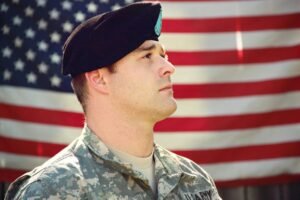No Beard Rule in US Military
|
General Studies Paper II: Effect of Policies & Politics of Countries on India’s Interests |
Why in News?
In September 2025, the U.S. Defense Secretary ordered to bring back the strict pre-2010 grooming standards, reintroducing the military’s “No-Beard” rule.
What are the Grooming Standards set by the US Military?
- In 2025, the U.S. Department of Defense released a directive titled “Grooming Standards for Facial Hair” to restore consistent grooming rules across all military branches.
- The memorandum highlighted that all military personnel must maintain a clean-shaven face at all times. Beards, goatees, and other facial hair are strictly prohibited unless specifically authorized.
- Mustaches are allowed but must be neatly trimmed. They cannot extend past the corners of the mouth or interfere with protective equipment.
- All applicants, including those seeking reentry, must meet grooming standards before entering service. Individuals unable to comply face deferred accession until they can meet the standards.
- All personnel must be clean-shaven when deployed to environments with a high risk of chemical, biological, radiological, or nuclear (CBRN) threats.
- Medical exceptions revert to pre-2020 standards. Only temporary profiles, such as for pseudofolliculitis barbae, are considered. All requests undergo an individualized review to assess operational impact.
- The Secretaries of the Military Departments submit an implementation plan within 60 days to the Under Secretary of War for Personnel and Readiness. The plan assesses training, certification, and possible barriers. Within 30 days of submission, departments issue implementing directives, including any approved exceptions.
Background of the ‘No-Beard’ Policy in US Military
- The no-beard rule in the U.S. military has roots going back to the 19th century, when clean-shaven faces were considered a mark of discipline and unity. During the Civil War, many soldiers had facial hair, but by the early 20th century, military leaders began enforcing uniform grooming for hygiene and professionalism.
- After World War II, the U.S. armed forces began emphasizing a clean and identical appearance among troops. The belief was that external uniformity reflected internal discipline. By the 1950s, regulations banning beards were fully implemented in most branches.
- The late 1970s and 1980s brought discussions around the grooming rules as American society experienced cultural change. The Navy briefly allowed beards under certain conditions in the 1970s, but the policy was reversed in 1984 due to equipment safety issues.
- By the 2000s, the U.S. military started receiving requests from soldiers seeking exemptions on religious or medical grounds. In 2010, the military started allowing limited exemptions in certain cases, marking the beginning of a new phase in its approach to grooming standards. Some service members from the Sikh, Muslim, and Orthodox Jewish communities sought permission to maintain beards as part of their faith.
- In 2017, the U.S. Army introduced policies allowing limited religious accommodations, updating Army Regulation Directive 2017-03.
- In 2019, several Sikh and Muslim soldiers received permanent approval to wear beards and turbans while serving, after legal appeals citing the Religious Freedom Restoration Act (1993).
Reasons Behind Reinstating the Grooming Standards?
- Ensure Proper Equipment Use: The military reinstates grooming standards to ensure personnel can safely use protective gear. Gas masks, firefighting equipment, and respirators require a tight seal on the face. Beards or facial hair can interfere with this seal. The rule prevents such risks and safeguards lives during high-threat operations.
- Promote Uniformity: The military views uniform grooming as a symbol of discipline and order. A clean-shaven force presents a cohesive and professional image. Leadership believes this standard will reduce distractions and enforces equality. Historical patterns from the 1950s onward show that appearance standards contribute to morale and respect for command.
- Maintain Operational Readiness: Clean-shaven standards help maintain operational readiness. Soldiers must deploy quickly in emergencies. Facial hair that disrupts mask fit can delay missions. Military leaders believe uniform grooming reduces risks of equipment failure. High-tempo deployments in conflicts like Iraq (2003–2011) and Afghanistan (2001–2021) highlighted the importance of standardization for rapid response.
- Protect Against CBRN Threats: The army wants the soldiers to protect from chemical, biological, radiological, and nuclear (CBRN) threats. Such threats demand flawless use of respiratory equipment. Even small gaps caused by facial hair can expose soldiers to toxic substances. These standards reduce casualties and improve mission success.
Concerns of the No-Beard Policy Decision
- Many faith communities express concerns about the reinstated no-beard rule. Sikh, Muslim, and Orthodox Jewish service members view facial hair as a key part of their religious identity. The restriction limits their ability to practice faith openly while serving. It raises questions about balancing discipline and religious liberty.
- The policy may affect recruitment and retention of diverse personnel. Studies from the Department of Defense in 2018 show inclusive policies improve retention and morale. Restricting facial hair could reduce interest from highly skilled individuals in specialized roles.
- Military history demonstrates that morale is critical for operational effectiveness, as seen in Vietnam War troop reports (1965–1973). The decision could impact morale within units. Soldiers who feel their beliefs are restricted may experience stress or frustration. This tension can affect teamwork and cohesion.
- Some personnel face medical concerns from shaving. Conditions like pseudofolliculitis barbae cause painful skin irritation and infections. Limiting exceptions to only temporary accommodations may worsen these conditions. Soldiers may require extra medical care, which can affect deployment readiness.
- The policy could trigger legal and ethical challenges regarding civil rights. Previous accommodations for religious beliefs followed the Religious Freedom Restoration Act (1993). Reverting to pre-2010 standards risks lawsuits or complaints from service members. This may raise ethical questions about balancing safety with individual rights.
|
Also Read: SC Flags Arbitrary Criteria in Women Officers Appointment |










